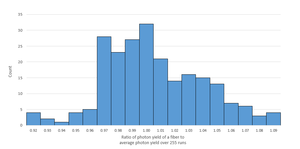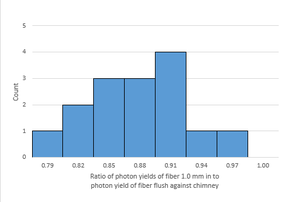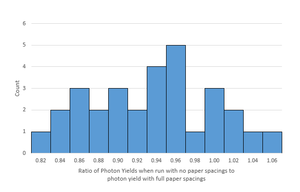LH Summer 2014
Jump to navigation
Jump to search
This summer I worked primarily on Fiber QA. My daily work journal can be found here. I'll summarize my tests here.
Here is Marco Campelli's Lab Journal.
Here is Suki Hyman's Lab Journal.
Results of Preliminary Fiber Tests
All preliminary fiber testing was recorded here.
Before we could run through all bundles through QA tests, we had to calibrate and standardize the QA testing procedure. We found the following sources of error:
- Laser Intensity - if the laser is brighter, each fiber will result in a higher photon yield. Dr. Jones has compensated for this. We also found that the photon yields decrease as the pulser's 9V battery is drained.
- Temperature of the SiPM board/Time Between Runs - we found that as the fiber runs were done repeatedly without turning off the electronics and removing the board, the photon yield decreases. Dr. Jones ran a script which automated the run process so that the runs began at the beginning of each hour. This histogram was made of 15 runs of 15 fibers (resulting in 255 data points) at approximately the same temperature (same time between runs) and compares each photon yield to the average over all runs. The standard deviation of any given ratio was 0.03
- Depth of the fibers in the chimney - We found that differences as small as 0.5 mm can have a minor affect on the photon yields. These histograms show the ratio of photon yields after a 0.5 mm or 1.0 mm fiber retraction to the photon yield while flush. The mean ratio for the 0.5 mm test was 0.95 with a standard deviation of 0.05 and the mean ratio for the 1.0 mm experiment was 0.88 with a standard deviation of 0.8
- Overall Environmental Factors - I did a series of runs where between each run, I'd turn off the electronics, remove the SiPM board, remove the fibers and replace the fibers so they're flush. Here you can see the overall variation between a bunch of runs. All of this variation is variation we will be present when we do the actual runs. The mean ratio was 0.99 with a standard deviation of 0.07
- Paper Spacers between scintillators- I tested the necessity of the paper spacers between the scintillating fibers. This histogram shows the ratios of individual fibers run with paper spacers and without. This is not all the data, however, three data points were excluded. The ratios were 0.45, 0.43, and 0.74 Because the lack of paper spacing resulting in three catastrophic results, it has been decided that the paper spacing is necessary.




